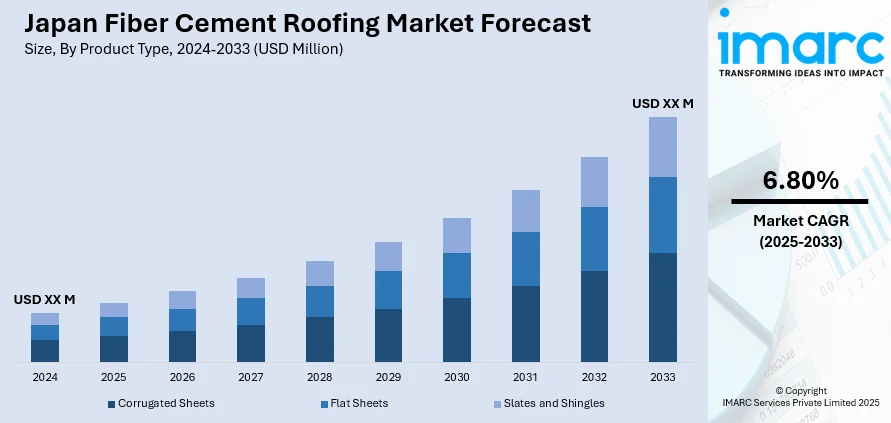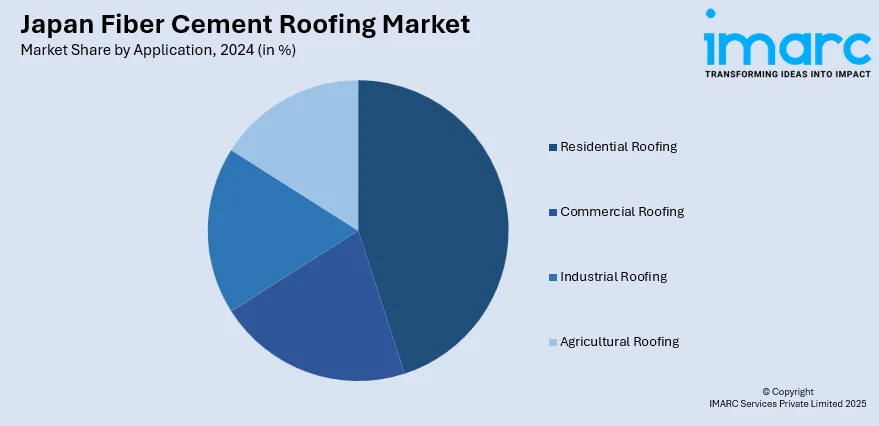
Japan Fiber Cement Roofing Market Size, Share, Trends and Forecast by Product Type, Material Composition, Application, End Use Sector, and Region, 2025-2033
Japan Fiber Cement Roofing Market Overview:
The Japan fiber cement roofing market size is projected to exhibit a growth rate (CAGR) of 6.80% during 2025-2033. The market is majorly driven by Japan’s need for fire-resistant, lightweight, and disaster-resilient roofing amid frequent earthquakes and severe weather. Considerable demand for renovation from aging housing stock supports the adoption of low-maintenance, structurally sound roofing materials, thereby fueling the market. Environmental mandates and green building standards are accelerating the number of sustainable roofing applications, further augmenting the Japan fiber cement roofing market share.
|
Report Attribute
|
Key Statistics
|
|---|---|
|
Base Year
|
2024
|
|
Forecast Years
|
2025-2033
|
|
Historical Years
|
2019-2024
|
| Market Growth Rate 2025-2033 | 6.80% |
Japan Fiber Cement Roofing Market Trends:
Seismic-Resistant, Fireproof, and Weather-Durable Roofing Preference
Japan’s geography exposes its buildings to frequent earthquakes, typhoons, and heavy rainfall, necessitating roofing solutions that combine structural integrity with high resistance to external stress. Japan faces some of the world’s highest natural disaster risks, with over 100 active volcanoes and a 70–80% chance of a megaquake along the Nankai Trough in the next 30 years. Fiber cement roofing offers fire resistance, water repellency, and low thermal conductivity, aligning with Japan’s stringent building codes and disaster-resilient construction practices. Its non-combustible nature also makes it highly desirable in densely populated urban areas where fire safety is paramount. Unlike traditional clay tiles, fiber cement is lighter and easier to handle during seismic retrofitting or post-disaster reconstruction. These characteristics reduce the risk of roof collapse during earthquakes and contribute to long-term safety. Builders and engineers value fiber cement for its adaptability in sloped and flat roof applications without compromising strength. With growing awareness of lifecycle performance and reduced maintenance needs, architects and property developers are increasingly specifying fiber cement roofing for residential, institutional, and commercial projects. The material’s compatibility with Japan’s disaster-resilience strategy is central to Japan fiber cement roofing market growth, aligning with national safety priorities and resilient urban development goals.

Sustainability Mandates and Green Building Initiatives
Japan’s commitment to carbon neutrality by 2050 has transformed construction practices, driving demand for environmentally responsible building materials, as part of a broader effort to cut greenhouse gas emissions by 46% by 2030, with ongoing work to reach 50%. Fiber cement roofing, composed of cellulose fibers, cement, and silica, is valued for its energy efficiency, low embodied carbon, and recyclability. Government-supported green building certifications, such as CASBEE, encourage the use of sustainable materials that offer thermal insulation, moisture resistance, and durability without harmful emissions. Fiber cement helps reduce cooling costs in summer months and limits material waste over time due to its long service life. As net-zero energy building (ZEB) policies advance, roofing systems that complement photovoltaic panels and insulation strategies are increasingly specified in both public and private sector projects. Developers aiming to qualify for sustainability-linked loans or subsidies are incorporating fiber cement into their designs, particularly for low-rise housing and educational institutions. The synergy between national decarbonization goals and material innovation is reinforcing fiber cement as a forward-compatible choice in green construction practices.
Japan Fiber Cement Roofing Market Segmentation:
IMARC Group provides an analysis of the key trends in each segment of the market, along with forecasts at the country and regional levels for 2025-2033. Our report has categorized the market based on product type, material composition, application, and end use sector.
Product Type Insights:
- Corrugated Sheets
- Flat Sheets
- Slates and Shingles
The report has provided a detailed breakup and analysis of the market based on the product type. This includes corrugated sheets, flat sheets, and slates and shingles.
Material Composition Insights:
- Asbestos Fiber Cement
- Non-Asbestos Fiber Cement
The report has provided a detailed breakup and analysis of the market based on the material composition. This includes asbestos fiber cement and non-asbestos fiber cement.
Application Insights:

- Residential Roofing
- Commercial Roofing
- Industrial Roofing
- Agricultural Roofing
The report has provided a detailed breakup and analysis of the market based on the application. This includes residential roofing, commercial roofing, industrial roofing, and agricultural roofing.
End Use Sector Insights:
- New Construction
- Replacement and Renovation
The report has provided a detailed breakup and analysis of the market based on the end use sector. This includes new construction and replacement and renovation.
Regional Insights:
- Kanto Region
- Kansai/Kinki Region
- Central/Chubu Region
- Kyushu-Okinawa Region
- Tohoku Region
- Chugoku Region
- Hokkaido Region
- Shikoku Region
The report has also provided a comprehensive analysis of all major regional markets. This includes Kanto Region, Kansai/Kinki Region, Central/Chubu Region, Kyushu-Okinawa Region, Tohoku Region, Chugoku Region, Hokkaido Region, and Shikoku Region.
Competitive Landscape:
The market research report has also provided a comprehensive analysis of the competitive landscape. Competitive analysis such as market structure, key player positioning, top winning strategies, competitive dashboard, and company evaluation quadrant has been covered in the report. Also, detailed profiles of all major companies have been provided.
Japan Fiber Cement Roofing Market Report Coverage:
| Report Features | Details |
|---|---|
| Base Year of the Analysis | 2024 |
| Historical Period | 2019-2024 |
| Forecast Period | 2025-2033 |
| Units | Million USD |
| Scope of the Report |
Exploration of Historical Trends and Market Outlook, Industry Catalysts and Challenges, Segment-Wise Historical and Future Market Assessment:
|
| Product Types Covered | Corrugated Sheets, Flat Sheets, Slates and Shingles |
| Material Compositions Covered | Asbestos Fiber Cement, Non-Asbestos Fiber Cement |
| Applications Covered | Residential Roofing, Commercial Roofing, Industrial Roofing, Agricultural Roofing |
| End Use Sectors Covered | New Construction, Replacement and Renovation |
| Regions Covered | Kanto Region, Kansai/Kinki Region, Central/Chubu Region, Kyushu-Okinawa Region, Tohoku Region, Chugoku Region, Hokkaido Region, Shikoku Region |
| Customization Scope | 10% Free Customization |
| Post-Sale Analyst Support | 10-12 Weeks |
| Delivery Format | PDF and Excel through Email (We can also provide the editable version of the report in PPT/Word format on special request) |
Key Questions Answered in This Report:
- How has the Japan fiber cement roofing market performed so far and how will it perform in the coming years?
- What is the breakup of the Japan fiber cement roofing market on the basis of product type?
- What is the breakup of the Japan fiber cement roofing market on the basis of material composition?
- What is the breakup of the Japan fiber cement roofing market on the basis of application?
- What is the breakup of the Japan fiber cement roofing market on the basis of end use sector?
- What is the breakup of the Japan fiber cement roofing market on the basis of region?
- What are the various stages in the value chain of the Japan fiber cement roofing market?
- What are the key driving factors and challenges in the Japan fiber cement roofing market?
- What is the structure of the Japan fiber cement roofing market and who are the key players?
- What is the degree of competition in the Japan fiber cement roofing market?
Key Benefits for Stakeholders:
- IMARC’s industry report offers a comprehensive quantitative analysis of various market segments, historical and current market trends, market forecasts, and dynamics of the Japan fiber cement roofing market from 2019-2033.
- The research report provides the latest information on the market drivers, challenges, and opportunities in the Japan fiber cement roofing market.
- Porter's five forces analysis assist stakeholders in assessing the impact of new entrants, competitive rivalry, supplier power, buyer power, and the threat of substitution. It helps stakeholders to analyze the level of competition within the Japan fiber cement roofing industry and its attractiveness.
- Competitive landscape allows stakeholders to understand their competitive environment and provides an insight into the current positions of key players in the market.
Need more help?
- Speak to our experienced analysts for insights on the current market scenarios.
- Include additional segments and countries to customize the report as per your requirement.
- Gain an unparalleled competitive advantage in your domain by understanding how to utilize the report and positively impacting your operations and revenue.
- For further assistance, please connect with our analysts.
 Request Customization
Request Customization
 Speak to an Analyst
Speak to an Analyst
 Request Brochure
Request Brochure
 Inquire Before Buying
Inquire Before Buying




.webp)




.webp)












